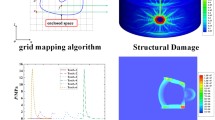Abstract
Research on failure law of target oil storage tank subjected to the coupling impact of multiple blast waves is one of the theoretical bases for domino effect accident prevention and control of chemical industrial parks. Taking the coupling impact of two-source blast waves as an example, the propagation law of blast waves in air and the distribution law of peak overpressure on the surface of tank wall are analyzed, and the dynamic response laws of displacement, stress, strain and energy for a 5000 m3 atmospheric steel arch-roof oil tank are studied by using ANSYS/LS-DYNA. The results are compared with those subjected to single blast wave and show that the maximum overpressure peak value is formed near the ground in 0° direction on the surface of tank wall, which is 79.6% larger than that subjected to single blast wave. The peak values of displacement, stress and strain for the tank wall subjected to the coupling impact of two-source blast waves are 114.9%, 39.6%, 134.9% larger than those subjected to single blast wave, respectively. The failure mode of arch-roof tank subjected to two-source blast waves is to form multiple concave plastic deformation zones on the explosion face, which extend to the surrounding area and produce plastic hinge lines and form irreversible residual deformation and cracking finally. The analysis results can provide reference for explosion-resistant design of tank structure and reasonable layout of tank area scene.

















Similar content being viewed by others
Change history
07 February 2020
In the original version of the article, some of the entries in Table��12 were misaligned. Following is the corrected table:
References
S.G. Davis, D. Engel, F. Gavelli, P. Hinze, O.R. Hansen, Advanced methods for determining the origin of vapor cloud explosions case study: the 2006 Danvers explosion investigation. Fire Technol. 50(4), 823–850 (2014)
A. Basheer, S.M. Tauseef, T. Abbasi, S.A. Abbasi, Methodologies for assessing risks of accidents in chemical process industries. J. Fail. Anal. Prev. 19(3), 623–648 (2019)
S.M. Tauseef, T. Abbasi, S.A. Abbasi, Risks of fire and explosion associated with the increasing use of liquefied petroleum gas. J. Fail. Anal. Prev. 10(4), 322–333 (2010)
S.M. Tauseef, R. Suganya, T. Abbasi, S.A. Abbasi, Chemical accident simulation tool (CAST): a system for assessing consequences of accidents in chemical process industry. J. Fail. Anal. Prev. 18(1), 101–116 (2018)
S.Z. Lu, W. Wang, Study of destruction mechanism of floating-roof oil tank under combustible gaseous explosion in a small scale experiment. Appl. Mech. Mater. 137, 65–71 (2012)
S.Z. Lu, W. Wang, Dynamic response of fixed-roof oil-storage tank structure under blast loading. J. Southeast Univ. (English Edition) 28(1), 58–63 (2012)
C. W. Zhang, W. Wang, X. H. Zhang, S. Z. Lu, Large scale blast emulator based explosive gas loading methods for structures and recent advances in experimental studies, in: Proceedings of the 8th International Conference on Shock & Impact Loads on Structures, pp. 769–779 (2009)
B.Y. Zhang, H.H. Li, W. Wang, Numerical study of dynamic response and failure analysis of spherical storage tanks under external blast loading. J. Loss Prev. Process Ind. 34, 209–217 (2015)
K. Hu, Y. Zhao, Numerical simulation of internal gaseous explosion loading in large scale cylindrical tanks with fixed roof. Thin Wall Struct. 105, 16–28 (2016)
K. Hu, Z. Wang, Y. Zhao, Numerical simulation of internal explosion loading in cone-roof cylindrical tanks, in: Proceedings of Seventh International Conference on Advances in Steel Structures (2012)
R.L. Zhang, J.J. Jia, H.F. Wang, Y.H. Guan, Shock response analysis of a large LNG storage tank under blast loads. KSCE J. Civ. Eng. 22(9), 3419–3429 (2018)
V. Mittal, T. Chakraborty, V. Matsagar, Dynamic analysis of liquid storage tank under blast using coupled Euler–Lagrange formulation. Thin Wall Struct. 84, 91–111 (2014)
G. Atkinson, Blast damage to storage tanks and steel clad buildings. Process Saf. Environ. Prot. 89(6), 382–390 (2011)
Y. H. Wang, M. X. Xiong, Analysis of axially restrained water storage tank under blast loading. Int. J. Impact Eng. 86, 167–178 (2015)
D.G. Weng, Q.Z. Ge, A dynamic response analysis of an extra-large LNG storage tank under blasting conditions. Nat. Gas Ind. 34(1), 139–145 (2014). (in Chinese)
B. Li, Engineering mechanics: analysis of dynamic response of large-scale liquid-storage vertical cylindrical tank under blast loads [Master degree]: Harbin Institute of Technology (2011) (in Chinese)
GB 50160-2008, Standard for fire prevention design of petrochemical enterprises (2018 Edition) (2018) (in Chinese)
L.L. Ding, X.Y. Li, F.Y. Lu, Z.Z. Li, H.H. Zhen, Research on damage characteristic of pressurized shell under the explosion shock wave loading. Sci. Technol. Eng. 16(26), 211–216 (2016). (in Chinese)
J.L. Chen, W.Y. Shu, J.W. Li, Experimental study on dynamic mechanical property of Q235 steel at different strain rates. J. Tongji Univ. (Nat. Sci.) 44(7), 1071–1075 (2016). (in Chinese)
Acknowledgments
This research is supported by the National Natural Science Foundation of China (Number: 21878102, 21576102), the Guangdong Basic and Applied Basic Research Foundation (2019A1515011157), China Scholarship Council (201906155051), and the Fundamental Research Funds for the Central Universities (2019MS066).
Author information
Authors and Affiliations
Corresponding author
Additional information
Publisher's Note
Springer Nature remains neutral with regard to jurisdictional claims in published maps and institutional affiliations.
The original version of this article was revised: In the original version of the article some of the entries in Table 12 were misaligned.
Rights and permissions
About this article
Cite this article
Chen, G., Wang, F., Zhou, C. et al. Dynamic Response Analysis of Large Arch-Roof Oil Tank Subjected to the Coupling Impact of Two-Source Blast Waves Based on Finite Element Method. J Fail. Anal. and Preven. 20, 333–347 (2020). https://doi.org/10.1007/s11668-020-00833-w
Received:
Revised:
Published:
Issue Date:
DOI: https://doi.org/10.1007/s11668-020-00833-w




